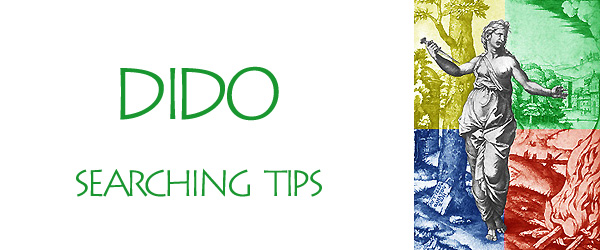
Searching Tips
OTHER IMAGE SOURCES
USEFUL LINKS
- The
DIDO Image Bank
can only be searched by two items at a time. Therefore, putting in three
separate elements will result in an unsuccessful search. The code line
(see more below) is considered one item, and each part of an artist's
name is also an item. So use only one part of a name when combining
a search with the code line.
- You can do simple Boolean
searches in the Image Bank. To form an AND
query, simply link two terms with an "and". To form an OR
query, simply list two terms.
- The DIDO Image Bank searches
an online database consisting of fourteen fields and returns the information
found in the first eight of them along with the associated image. The
additional fields allow for subject access, but many of these are still
not completed.
- Once you have performed
an initial query, you can narrow down the list by clicking on the boxes
located left of the images and then saving this group (there is a button
provided) . You can click on a thumbnail at any time to see a larger
version of the image.
- Because the search engine
looks for character strings, if you put in "van Gogh" it will look for
everything with the letters "van" as well as "Gogh". This will result
in a huge list of mostly unrelated images. It is better to search using
only "Gogh" to return images by van Gogh.
- Similarly, putting in "Roman"
might not return all available Roman images because the word "Roman"
may not appear in any of the fields in its full form. But putting in
just "rom" will return all images that have the words "from" or "romanesque"
in a field.
- So, to search effectively,
you must find the middle ground between these two approaches. Be as
specific as possible, but don't reduce the word strings to such a small
amount that they would likely appear in other common words.
- One of the best ways to
search this database for images of a common type is to search the code
line associated with each image. All code lines have three basic elements:
the time period, the media and the country. For example, van Gogh's
code line is 19.PTG.NETH and Roman architecture's
code line is ANC.ROM.ARCH.
- Time periods are represented
by ANC for ancient, MED
for Medieval, RB for Renaissance/Baroque
and 18, 19, 20 and 21 for these centuries.
- Media components of
a code line can include : SCULPT for
sculpture, ARCH for architecture, MSS
for manuscripts and PRINT for graphic
media. Photography and our new 21st Century division use only the
PHOTO or 21
codes without country or time period components. There are many
other media codes. Please see the Slide Library for additional information.
- The country might also be abbreviated. A few examples include: US for United States, CZECH for Czechoslovakia and SWITZ for Switzerland.
- Time periods are represented
by ANC for ancient, MED
for Medieval, RB for Renaissance/Baroque
and 18, 19, 20 and 21 for these centuries.
- Perform a few sample searches first to see what the results are, and what the fields look like. Then, with practice, you will be able to search much more effectively.
Comments?
Questions? Mail the administrator
Last Updated 8/29/03